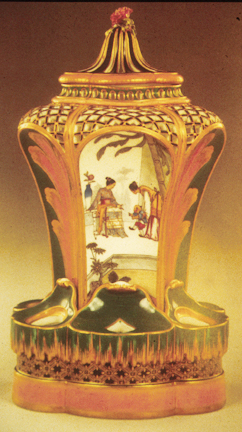This vase is one of a pair of pot pourri vases from the collection of Madame du Pompadour. She had wall sconces to match (of course). This container from Sèvres is unusual in that it is painted with 3 of the overglaze colors, vert, noir, and rose, whereas most Sèvres porcelain uses only one or at the most two overglaze colors in the surface design. This piece is a prime example of the rococo style. Intimate, sinuous, elaborate, and rich, it reeks of opulence and wealth. Note the panel in the center, painted with Asian figures and details, making this also an example of 'chinoiserie,' or work done in the Chinese style. The upper area, near the shoulder, is perforated so that the fragrance of the pot pourri could waft into the room and scent the air
The rococo period lasted for only 50 years, from 1700 to around 1750 CE. The term rococo derives from the French word 'rocaille' meaning pebble, referring to the small stones used to decorate the interiors of grottos. The rococo style is essentially an interior style of small decorative objects, art, furniture, utensils, and other furnishings. This period was that of chamber music, elaborate wigs and vestments and private entertainments. It would be the last gasp of a dying age preceding the American and French revolutions.

'One of a pair of pot-pourri vases, Sèvres Porcelain, France 1760 CE
Soft Paste Porcelain with overglaze enamel and luster


